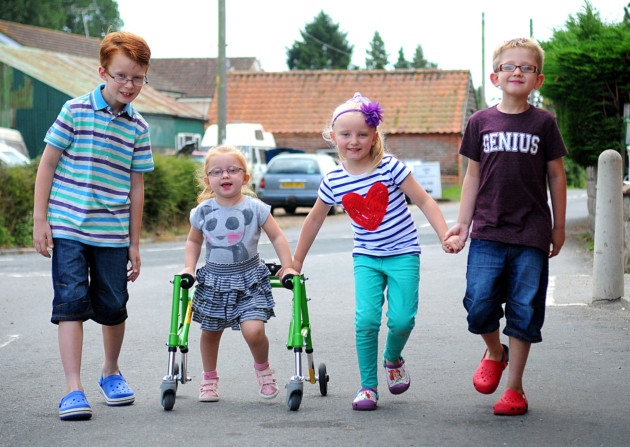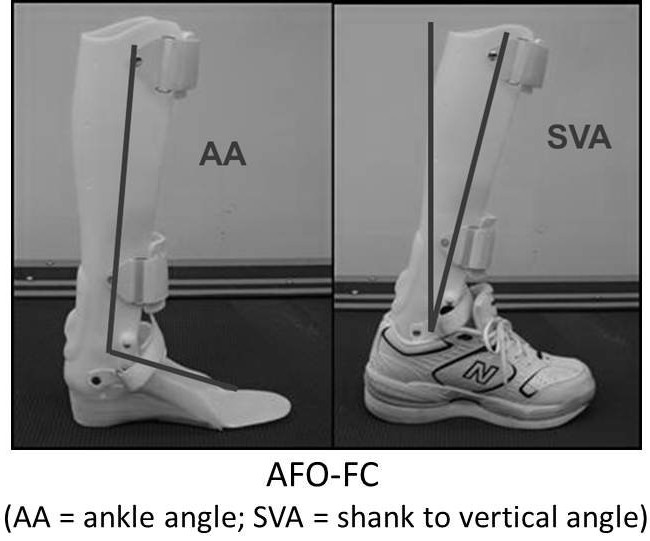Improving lower extremity orthotics management for children with cerebral palsy

Some cerebral palsy cases caused by genetic anomalies, not just brain injury: study. Antony Kelly Photo 570 News
Larissa Pavone MD, Deborah Gaebler-Spira MD, Donald McGovern CPO FAAOP, Steven Makovitch MD, Stefania Fatone PhD, Rehabilitation Institute of Chicago, Northwestern University Feinberg School of Medicine
| Introduction |
Cerebral Palsy (CP) is the most common cause of motor disability in childhood and each child with CP has unique motor control issues that affect posture, standing balance, and gait.
In conjunction with other medical, surgical, and therapeutic interventions, orthoses play an important role in the physical management of children with CP. For ambulant children with CP, evidence from gait laboratory studies suggest that ankle foot orthoses (AFOs) that prevent plantar flexion can improve temporospatial parameters of gait and ankle kinematics.
More limited evidence exists for the indirect effects of AFOs on knee and hip kinematics and kinetics, with some suggestion that these effects can be optimized by ‘tuning’ solid AFOs and footwear. ‘Tuning’ focuses on manipulating segment kinematics, in particular shank (i.e., tibial) kinematics, to improve the relationship of the vertical ground reaction force (GRF) vector to the knee and hip during stance. However, most studies do not report systematically fine-tuning orthosis alignment or footwear when evaluating standing and walking in CP.
 An approach to tuning of AFOs and footwear has been recently characterized and dubbed the Ankle Foot Orthosis-Footwear Combination (AFO-FC). The tuned AFO-FC consists of a rigid, non-articulated AFO in which Ankle Angle (AA) and Shank-to-Vertical Angle (SVA) are considered separately (see picture). AA refers to the angle of the ankle in the AFO and is based on measurements of muscle length, while SVA refers to the ankle of the shank/tibia with respect to vertical during standing and walking. Modified footwear is used in addition to wedges under the heel of the AFO and/or shoe to tune the SVA. Ideally a video vector visualization system is used to help determine optimal tuning of the AFO-FC.
An approach to tuning of AFOs and footwear has been recently characterized and dubbed the Ankle Foot Orthosis-Footwear Combination (AFO-FC). The tuned AFO-FC consists of a rigid, non-articulated AFO in which Ankle Angle (AA) and Shank-to-Vertical Angle (SVA) are considered separately (see picture). AA refers to the angle of the ankle in the AFO and is based on measurements of muscle length, while SVA refers to the ankle of the shank/tibia with respect to vertical during standing and walking. Modified footwear is used in addition to wedges under the heel of the AFO and/or shoe to tune the SVA. Ideally a video vector visualization system is used to help determine optimal tuning of the AFO-FC.
| Specific Aims |
The specific aims of this study are to demonstrate that AFO-FCs improve knee and hip kinematics and kinetics during walking to a greater extent than ‘conventional’ AFOs, leading to improved balance, step length, walking speed, and self-reported function, and that these improvements increase with time. For the purpose of this study, ‘conventional’ AFOs are any design of orthosis that does not involve systematically fine-tuning orthosis alignment or footwear. We will use the Pediatric Balance Scale (PBS), the Pediatric Outcomes Data Collection Instrument (PODCI), the Orthotic and Prosthetic User Survey (OPUS), and instrumented gait analysis to compare AFO-FCs to conventional AFOs.
We will conduct a repeated measures pilot study of 3 children with spastic diplegic CP who have worn conventional AFOs for at least 6 months. Baseline clinical measures will include joint range of motion, muscle strength, muscle stiffness, selective motor control, and spasticity. A single orthotist will provide each subject with an AFO-FC fabricated and tuned per published algorithms. Tuning will be accomplished with assistance of ground reaction force visualization in the motion analysis lab. Gait analyses will be conducted with and without the conventional AFOs, and after one week and 4 months of AFO-FC wear.
| Funded by Orthotics and Prosthetics Education and Research Foundation (OPERF) |
 Source Northwestern University Feinberg School of Medicine
Source Northwestern University Feinberg School of Medicine
| Presentations |
Effect of two orthotic approaches on activity level, balance & satisfaction in children with cerebral palsy (CP), Fatone S, Gaebler-Spira D, McGovern D, Clancy T, Conaway P, Quigley M. (2015) International Society of Prosthetics and Orthotics Congress, June 22-25, Lyon, France.
Effect of Ankle-Foot Orthosis Footwear Combinations (AFO-FCs) on Gait Biomechanics and Function in Children with Cerebral Palsy, Fatone S, McGovern D, Makovitch S, Pavone L. (2013) Rehabilitation Institute of Chicago Motion Analysis Center, 22nd Visiting Professor Day, November 8, Chicago, Illinois.
Improving lower extremity orthotic management of children with Cerebral Palsy: AFO-FC case studies, Fatone S, Stine R, McGovern D, Pavone L. (2014) 40th American Academy of Orthotists and Prosthetists Annual Meeting & Scientific Symposium, February 26-March 1, Chicago, Illinois.
Evaluating the effects of ankle-foot-orthosis footwear-combinations in children with cerebral palsy, Fatone S. (2014) Initiative ’93 Technische Orthopädie Symposium, March 3, Chicago, Illinois.
Evaluating the effects of ankle-foot-orthosis footwear-combinations (AFO-FCs) in children with Cerebral Palsy, McGovern D, Fatone S. (2014) Midwest Chapter of the American Academy of Orthotists and Prosthetists, One Day Fall Symposium, November 15; Hickory Hills, Illinois.
| Further reading |
Pilot Study: Effect of Two Orthotic Approaches to Ankle Motion Restriction on Activity Level, Balance and Patient Satisfaction in Children with Cerebral Palsy, Co-Investigators: Stefania Fatone, PhD; Donald McGovern, CPO, FAAOP*; Theresa Clancy, PT* Deborah Gaebler-Spira, MD Project Director*; Petra Conaway, PT, Study Coordinator*; *Rehabilitation Institute of Chicago. Funded by: Ultraflex Systems
Improving Lower Extremity Orthotic Management of Children with Cerebral Palsy, Co-Investigators: Larissa Pavone, MD*; Deborah Gaebler-Spira, MD*; Donald McGovern, CPO, FAAOP*; Steven Makovitch, MD*; *Rehabilitation Institute of Chicago. Project Director: Stefania Fatone, PhD, BPO(Hons). Funded by: Orthotics and Prosthetics Education and Research Foundation (OPERF)
Ankle-foot orthoses in children with cerebral palsy: a cross sectional population based study of 2200 children, Wingstrand M, Hägglund G, Rodby-Bousquet E, BMC Musculoskelet Disord. 2014 Oct 2;15:327. doi: 10.1186/1471-2474-15-327.
Orthotic management of cerebral palsy: recommendations from a consensus conference, Morris C, Bowers R, Ross K, Stevens P, Phillips D. NeuroRehabilitation. 2011;28(1):37-46. doi: 10.3233/NRE-2011-0630
Also see
Some cerebral palsy cases caused by genetic anomalies, not just brain injury: study 570 News Rogers Media
